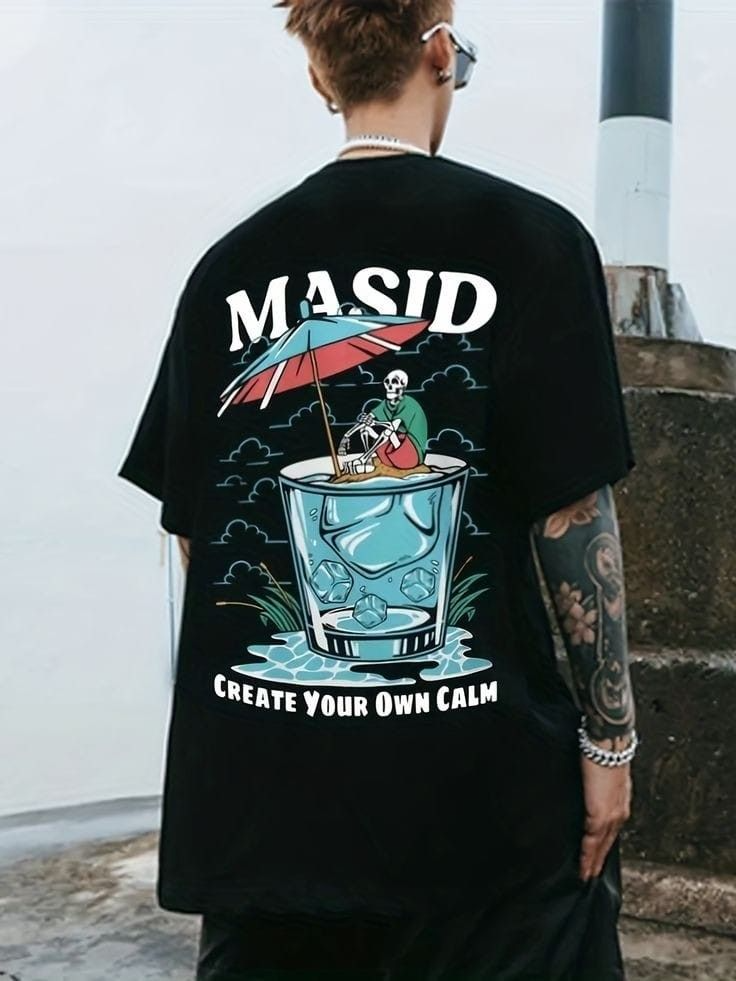Currently Empty: $0.00

Introduction
The t-shirt is a garment that transcends time, culture, and socio-economic barriers. It is worn by people from all walks of life, from children to adults, across all continents. Originally intended as an undergarment, the t-shirt has evolved into a statement piece of fashion, self-expression, and even activism. Its simplicity in design and functionality has made it a versatile piece in almost every wardrobe, yet it carries immense significance in the global fashion landscape. Whether plain or graphic, in cotton or polyester, the t-shirt is no longer just a piece of clothing but an important symbol in fashion and popular culture.
This article explores the origins, cultural significance, and continued evolution of the t-shirt, from its modest beginnings to its establishment as a key player in modern fashion. It will also delve into the impact of graphic designs, the rise of t-shirt-related subcultures, and how the t-shirt industry has responded to changes in consumer demands, from sustainability to digital design innovations.
The Origins of the T-Shirt
The journey of the t-shirt began in the late 19th century, when it was first introduced as a functional undergarment for military personnel. The U.S. Navy in particular was one of the first to issue lightweight, short-sleeved cotton shirts to sailors during the Spanish-American War (1898). These t-shirts were practical in hot climates and served as an alternative to the traditional woolen uniforms, providing comfort and ventilation during the summer months. The design was simple: a round neckline and short sleeves, often with a loose fit, offering easy movement for workers and soldiers alike.
By the early 20th century, t-shirts became more widely used in industrial settings, providing a cool alternative to the heavier clothing that was typically worn for work. This was especially important for blue-collar workers in factories, as the garment allowed them to move freely in hot, physically demanding environments. However, it wasn’t until the mid-20th century, particularly after World War II, that the t-shirt began to make its way into mainstream fashion.
The introduction of mass production methods and the growing demand for more casual clothing played a pivotal role in the garment’s transformation. By the 1940s and 1950s, t-shirts were no longer seen as just undergarments but were embraced as comfortable and practical outerwear, especially among the youth. The simple yet versatile nature of the t-shirt made it a go-to piece in postwar America, a shift that had a lasting influence on fashion trends for generations to come.
The Rise of the T-Shirt as Casual Wear
The post-WWII era saw major changes in the Western world, including an increasing cultural emphasis on youth, freedom, and individuality. These societal shifts gave rise to a more relaxed approach to dressing. Casual wear became more popular, and as a result, the t-shirt became central to the new fashion identity. The 1950s marked the beginning of the t-shirt’s mainstream popularity, as Hollywood stars like Marlon Brando in A Streetcar Named Desire (1951) and James Dean in Rebel Without a Cause (1955) wore them in iconic roles, elevating the t-shirt’s status.
Brando’s portrayal of the rebellious, brooding character in A Streetcar Named Desire is often credited with popularizing the t-shirt as a symbol of defiance and masculinity. The casualness of the t-shirt, combined with the actor’s tough image, resonated with a generation of young people. The t-shirt became an emblem of youthful rebellion, distancing itself from the stiff, formal attire of previous generations.
In the 1960s, the t-shirt’s role as a medium for self-expression began to take shape. The counterculture movement, which was pushing for social change and challenging the status quo, used clothing as a form of protest. Activists and young people began wearing t-shirts emblazoned with political messages, slogans, and art that symbolized their causes. The rise of political movements such as the Civil Rights Movement, Feminism, and Anti-Vietnam War protests all played a role in making the t-shirt a vehicle for social and political expression.
Graphic T-Shirts and the Power of Self-Expression
The graphic t-shirt as we know it today began to take form in the 1970s and 1980s. As a way for individuals to visually represent their identities, beliefs, and passions, graphic t-shirts became an essential part of youth culture. The surge in popularity of rock bands, pop culture, and various subcultures played a huge role in shaping the graphic t-shirt’s widespread appeal. People wore their favorite bands’ logos, political slogans, and pop culture references proudly on their chest, and graphic design became a form of communication and expression.
Band t-shirts became iconic. Wearing a Led Zeppelin, The Rolling Stones, or The Ramones shirt wasn’t just about showcasing musical tastes; it was about aligning oneself with a specific identity and lifestyle. The bold graphics on these shirts were more than just decorations—they told stories about who the wearer was and what they stood for.
Additionally, the 1980s and 1990s saw the rise of mass-produced graphic t-shirts that made it possible for everyday consumers to purchase shirts with popular logos, movie quotes, and quirky designs. The advent of screen printing and digital printing technology enabled t-shirt manufacturers to create intricate designs on fabric at a relatively low cost, allowing for an explosion of creative expression. T-shirts became a canvas for artists, photographers, and graphic designers to create visually captivating and often thought-provoking pieces of wearable art.
T-Shirt Styles and Variations
- Basic T-Shirts: The most common and fundamental form of t-shirt is the classic, plain, solid-color variety. These versatile pieces are a staple in almost every wardrobe due to their simplicity and adaptability. A basic t-shirt can be worn on its own or layered under jackets, cardigans, or sweaters, making it suitable for all seasons. Over time, manufacturers have introduced various color options, cuts, and styles to suit different body types and personal preferences.
- V-Neck vs. Crew Neck: One of the primary style choices in t-shirts comes down to the neckline. The crew neck, with its round collar, is the classic style and the most common for everyday wear. On the other hand, the v-neck offers a more flattering shape, often elongating the neck and creating a slightly dressier look. The choice between v-neck and crew neck is often a matter of personal taste, but both variations have contributed significantly to the t-shirt’s evolution.
- Long-Sleeve and Short-Sleeve T-Shirts: T-shirts are also available in varying sleeve lengths, with short-sleeve designs being the most common for warm weather. Long-sleeve t-shirts offer more versatility, especially in cooler climates, and can serve as a layering piece for fall and winter wardrobes. Both styles can feature the same types of graphic designs or remain plain.
- Custom and DIY T-Shirts: With the rise of online platforms like Teespring and Redbubble, custom and DIY t-shirts have become increasingly popular. Consumers now have the ability to create their own designs, resulting in a unique and personalized garment. This trend has expanded the creative possibilities of t-shirt design, with people using t-shirts as a form of self-expression in ways that were previously not as accessible.
- Vintage and Retro T-Shirts: Nostalgia has played a huge role in fashion, and the t-shirt is no exception. Vintage and retro-style t-shirts, often featuring classic logos, advertisements, and pop culture icons from previous decades, have surged in popularity. Whether it’s a band tee from the ’70s or a throwback graphic from a ’90s sitcom, these shirts evoke a sense of fondness for the past and are highly sought after by fashion enthusiasts and collectors.
The Cultural Impact of the T-Shirt
The t-shirt has solidified itself as more than just a practical garment; it has become a powerful cultural symbol. The influence of the t-shirt in music, sports, and politics cannot be overstated.
Music: Band t-shirts have long been a central part of music culture. Fans proudly wear shirts emblazoned with their favorite artists’ logos or album artwork, marking their allegiance to specific genres and communities. In particular, rock and roll culture has used the t-shirt as a tool for branding and establishing identity. The Beatles, Nirvana, and The Clash all made their mark on the fashion world through their iconic t-shirts, which continue to be worn decades later.
Sports: Sports fans use t-shirts to show their support for teams, players, and events. From simple designs featuring a team’s logo to replica jerseys that mirror professional athletic gear, t-shirts have become synonymous with fandom. This trend extends beyond mainstream professional leagues and is also seen in college and local sports teams.
Politics: The t-shirt has also been a vehicle for political expression. From the “I AM A MAN” shirts worn during the Civil Rights Movement to t-shirts bearing the slogans of modern political campaigns, the t-shirt has played a significant role in advocating for change. The t-shirt has become a way for individuals to show support for causes and movements, from environmentalism to LGBTQ+ rights.
The T-Shirt Industry
The global t-shirt industry is massive, encompassing both fast fashion giants and high-end luxury brands. Retailers like H&M, Zara, and Uniqlo have made t-shirts accessible to the masses by producing affordable, trendy versions in a variety of styles, colors, and fabrics. Fast fashion brands have capitalized on the t-shirt’s popularity, producing large quantities at low cost, making it possible for consumers to buy multiple shirts at once.
At the same time, t-shirts have also become a key player in high fashion. Luxury brands such as Balenciaga, Gucci, and Off-White have redefined the t-shirt as a statement piece within the fashion world. Oversized cuts, bold graphics, and innovative designs have made the t-shirt a central

